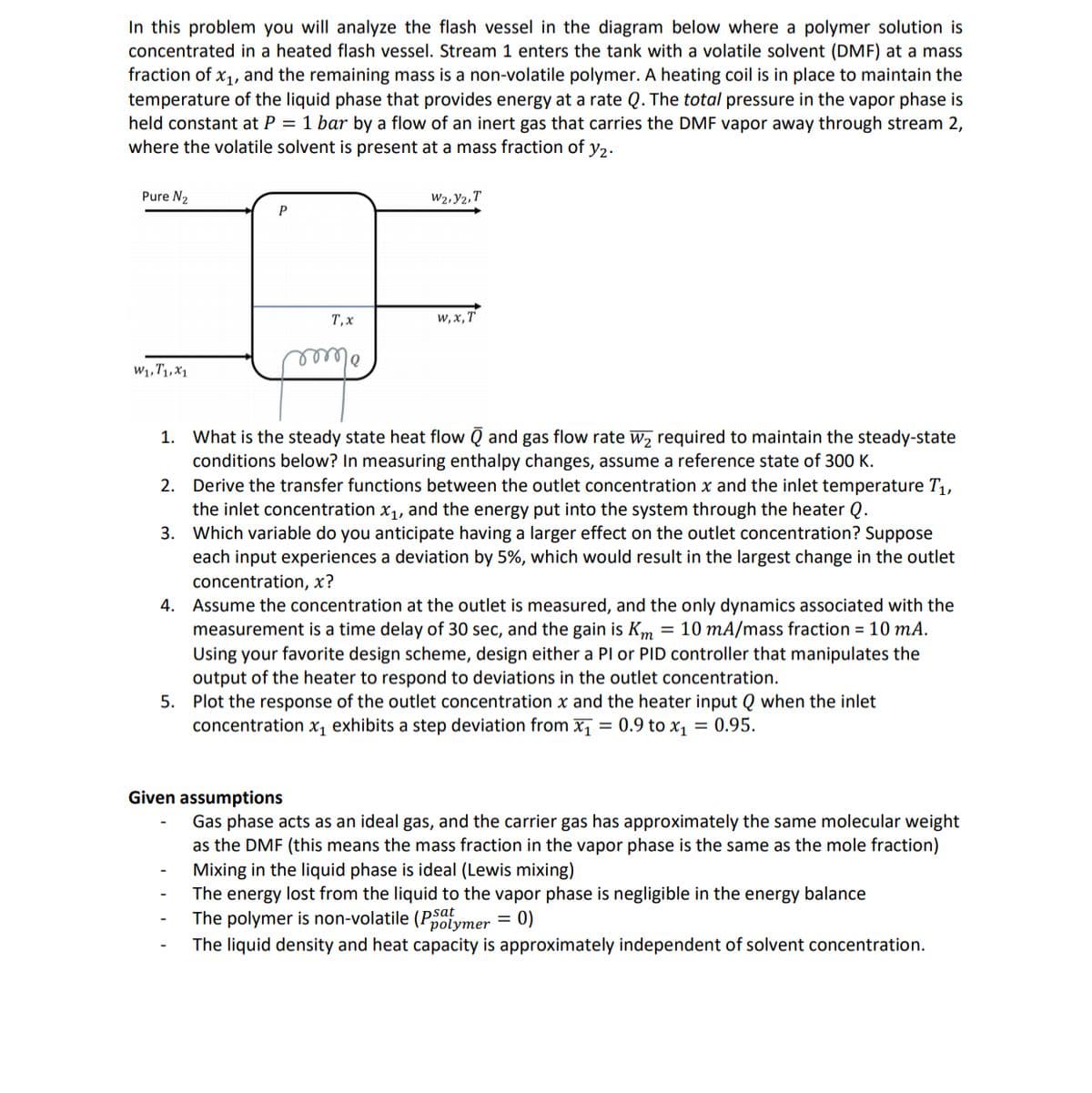Data p = 950 n³ T = 350 K 150L mol-K Mw.DMF = 73.1 gm mol Cy = Viia = 2 m3 kg w = 180- min T = 325 K P = 1 bar X1 = 0.9 %3D kg i = 0.6 W1 = 200- min %3D Antoine equation for DMF: в log10 PEF = A – C+T' , with Psat[=] bar and T[=] K A = 3.93068 B = 1337.716 C = -82.648
Data p = 950 n³ T = 350 K 150L mol-K Mw.DMF = 73.1 gm mol Cy = Viia = 2 m3 kg w = 180- min T = 325 K P = 1 bar X1 = 0.9 %3D kg i = 0.6 W1 = 200- min %3D Antoine equation for DMF: в log10 PEF = A – C+T' , with Psat[=] bar and T[=] K A = 3.93068 B = 1337.716 C = -82.648
Chemistry
10th Edition
ISBN:9781305957404
Author:Steven S. Zumdahl, Susan A. Zumdahl, Donald J. DeCoste
Publisher:Steven S. Zumdahl, Susan A. Zumdahl, Donald J. DeCoste
Chapter1: Chemical Foundations
Section: Chapter Questions
Problem 1RQ: Define and explain the differences between the following terms. a. law and theory b. theory and...
Related questions
Question
![Data
kg
p = 950
m3
Cy = 150L
mol·K
Mw.DMF = 73.1 gm
mol
Viia = 2 m3
T = 350 K
T = 325 K
X1 = 0.9
kg
w = 180
min
ī = 0.6
P = 1 bar
W1 = 200-
min
kg
Antoine equation for DMF:
B
log10 PEiE = A –
C+T'
with Psat[=] bar and T[=] K
A = 3.93068
B = 1337.716 C = -82.648](/v2/_next/image?url=https%3A%2F%2Fcontent.bartleby.com%2Fqna-images%2Fquestion%2Fe5d528f6-f704-4253-8470-44f2fbc0de86%2Fdffe3160-8dff-4977-a8bb-0fab1b2d4e41%2Fdmi5msd_processed.jpeg&w=3840&q=75)
Transcribed Image Text:Data
kg
p = 950
m3
Cy = 150L
mol·K
Mw.DMF = 73.1 gm
mol
Viia = 2 m3
T = 350 K
T = 325 K
X1 = 0.9
kg
w = 180
min
ī = 0.6
P = 1 bar
W1 = 200-
min
kg
Antoine equation for DMF:
B
log10 PEiE = A –
C+T'
with Psat[=] bar and T[=] K
A = 3.93068
B = 1337.716 C = -82.648

Transcribed Image Text:In this problem you will analyze the flash vessel in the diagram below where a polymer solution is
concentrated in a heated flash vessel. Stream 1 enters the tank with a volatile solvent (DMF) at a mass
fraction of x1, and the remaining mass is a non-volatile polymer. A heating coil is in place to maintain the
temperature of the liquid phase that provides energy at a rate Q. The total pressure in the vapor phase is
held constant at P = 1 bar by a flow of an inert gas that carries the DMF vapor away through stream 2,
where the volatile solvent is present at a mass fraction of y2.
Pure N2
W2, Y2, T
P
T, x
w, x, T
W1,T1,X1
olec
1. What is the steady state heat flow Q and gas flow rate W, required to maintain the steady-state
conditions below? In measuring enthalpy changes, assume a reference state of 300 K.
Derive the transfer functions between the outlet concentration x and the inlet temperature T,,
the inlet concentration x1, and the energy put into the system through the heater Q.
Which variable do you anticipate having a larger effect on the outlet concentration? Suppose
each input experiences a deviation by 5%, which would result in the largest change in the outlet
2.
3.
concentration, x?
4. Assume the concentration at the outlet is measured, and the only dynamics associated with the
measurement is a time delay of 30 sec, and the gain is Km = 10 mA/mass fraction = 10 mA.
Using your favorite design scheme, design either a Pl or PID controller that manipulates the
output of the heater to respond to deviations in the outlet concentration.
5. Plot the response of the outlet concentration x and the heater input Q when the inlet
concentration x, exhibits a step deviation from x, = 0.9 to x, = 0.95.
Given assumptions
Gas phase acts as an ideal gas, and the carrier gas has approximately the same molecular weight
as the DMF (this means the mass fraction in the vapor phase is the same as the mole fraction)
Mixing in the liquid phase is ideal (Lewis mixing)
The energy lost from the liquid to the vapor phase is negligible in the energy balance
The polymer is non-volatile (Polymer = 0)
The liquid density and heat capacity is approximately independent of solvent concentration.
Expert Solution
This question has been solved!
Explore an expertly crafted, step-by-step solution for a thorough understanding of key concepts.
This is a popular solution!
Trending now
This is a popular solution!
Step by step
Solved in 2 steps

Knowledge Booster
Learn more about
Need a deep-dive on the concept behind this application? Look no further. Learn more about this topic, chemistry and related others by exploring similar questions and additional content below.Recommended textbooks for you

Chemistry
Chemistry
ISBN:
9781305957404
Author:
Steven S. Zumdahl, Susan A. Zumdahl, Donald J. DeCoste
Publisher:
Cengage Learning

Chemistry
Chemistry
ISBN:
9781259911156
Author:
Raymond Chang Dr., Jason Overby Professor
Publisher:
McGraw-Hill Education

Principles of Instrumental Analysis
Chemistry
ISBN:
9781305577213
Author:
Douglas A. Skoog, F. James Holler, Stanley R. Crouch
Publisher:
Cengage Learning

Chemistry
Chemistry
ISBN:
9781305957404
Author:
Steven S. Zumdahl, Susan A. Zumdahl, Donald J. DeCoste
Publisher:
Cengage Learning

Chemistry
Chemistry
ISBN:
9781259911156
Author:
Raymond Chang Dr., Jason Overby Professor
Publisher:
McGraw-Hill Education

Principles of Instrumental Analysis
Chemistry
ISBN:
9781305577213
Author:
Douglas A. Skoog, F. James Holler, Stanley R. Crouch
Publisher:
Cengage Learning

Organic Chemistry
Chemistry
ISBN:
9780078021558
Author:
Janice Gorzynski Smith Dr.
Publisher:
McGraw-Hill Education

Chemistry: Principles and Reactions
Chemistry
ISBN:
9781305079373
Author:
William L. Masterton, Cecile N. Hurley
Publisher:
Cengage Learning

Elementary Principles of Chemical Processes, Bind…
Chemistry
ISBN:
9781118431221
Author:
Richard M. Felder, Ronald W. Rousseau, Lisa G. Bullard
Publisher:
WILEY